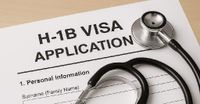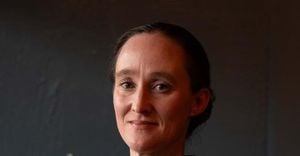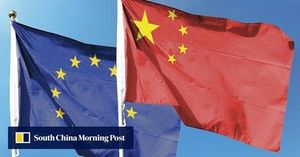Doctors and medical residents across the United States may soon find themselves at the center of a high-stakes debate over immigration policy, healthcare access, and the future of rural medicine. On Monday, September 22, 2025, the White House announced that physicians could qualify for exemptions from the Trump administration’s newly instituted $100,000 fee for high-skilled H-1B visa applications—a move that has drawn both relief and skepticism from the nation’s leading medical organizations.
The executive order, released just days earlier on Friday, September 19, 2025, set off alarm bells across the healthcare sector. The order mandates that applicants for H-1B visas—commonly used by hospitals to recruit foreign-born doctors and medical residents—must pay a staggering $100,000 fee. However, the order also includes a provision: the Secretary of Homeland Security has the authority to waive these fees if hiring is deemed to be "in the national interest." White House spokesperson Taylor Rogers clarified in an email to Bloomberg News, "The Proclamation allows for potential exemptions, which can include physicians and medical residents. Ultimately, the Trump Administration defers to the language in the proclamation."
The stakes are especially high for rural America, where the shortage of healthcare providers is already at crisis levels. According to a 2024 government analysis cited by Bloomberg, the United States is projected to face a shortfall of over 87,000 primary care physicians by 2037. The situation is most dire in rural communities: more than 76 million Americans live in areas officially designated as having a shortage of primary care doctors, based on federal data compiled by health research group KFF.
Hospitals in these underserved regions have long relied on the H-1B visa program to fill critical gaps in their workforce. As of June 2025, more than 4,000 hospitals and research centers across the country were sponsoring visas for healthcare workers, according to federal data from the US Citizenship and Immigration Service. For many rural hospitals, these programs are not just helpful—they are essential to keeping their doors open.
Medical organizations were quick to voice their concerns about the new fee. On September 22, 2025, several prominent groups warned that the $100,000 charge could have devastating consequences for patient care, particularly in rural and underserved communities. American Medical Association President Bobby Mukkamala, a Michigan-based head and neck surgeon, did not mince words: "The fee for H-1B visas risks shutting off the pipeline of highly trained physicians that patients depend on, especially in rural and underserved communities," he told Bloomberg.
Health care employers, for their part, have often sponsored medical residents and other physicians on H-1B visas to address these shortages. The American Hospital Association (AHA) echoed these concerns, emphasizing the need for flexibility. "We will also work with the Administration to stress the importance of including health care personnel in potential exemptions to these changes," an AHA spokesperson said, as reported by Bloomberg.
While the White House’s statement about potential exemptions has provided a glimmer of hope, many questions remain unresolved. Will doctors and medical residents be able to secure an industry-wide exemption, or will each applicant have to plead their case individually to the Department of Homeland Security? The answer could determine whether thousands of communities continue to have access to essential medical services—or see their local hospitals struggle even more to recruit desperately needed staff.
The broader context of these changes is equally important. The Trump administration has long championed efforts to reduce health-care spending, including supporting a bill that would cut Medicaid spending by about $1 trillion over ten years. At the same time, the administration has allocated $50 billion to rural health initiatives over five years. While Medicaid coverage rates are slightly higher in rural areas than in urban ones, according to a KFF analysis, the overall funding picture remains complex and, some argue, insufficient to meet the growing demand.
For many rural hospitals, the H-1B visa program is a lifeline. Without access to foreign-trained physicians, administrators warn that already stretched staff could become overwhelmed, leading to longer wait times, reduced services, and even hospital closures in extreme cases. According to Bloomberg, health care employers often sponsor medical residents and other physicians through the H-1B program, a practice that has become increasingly vital as the national physician shortage worsens.
Medical groups argue that the new fee risks exacerbating an already precarious situation. "The fee for H-1B visas risks shutting off the pipeline of highly trained physicians that patients depend on, especially in rural and underserved communities," said AMA President Bobby Mukkamala, reiterating the organization’s fears about the long-term impact on patient care.
As the debate unfolds, policymakers face a delicate balancing act. On one hand, there is a clear desire to tighten immigration rules and reduce federal spending. On the other, the practical realities of America’s healthcare system—especially outside major metropolitan areas—require a steady influx of skilled doctors, many of whom come from abroad. The executive order’s exemption clause offers a potential compromise, but its effectiveness will hinge on how it is implemented in practice.
For now, hospitals, medical associations, and rural communities are watching closely. The AHA has pledged to work with the administration to ensure that health care personnel are included in any exemptions, while the White House has signaled a willingness to consider such requests. Yet, until the details are ironed out, uncertainty will continue to hang over the future of rural healthcare in the United States.
As the country grapples with a projected shortage of tens of thousands of doctors over the next decade, the outcome of this policy debate could shape the landscape of American medicine for years to come. For the millions of Americans living in areas already starved for care, the stakes could hardly be higher.






